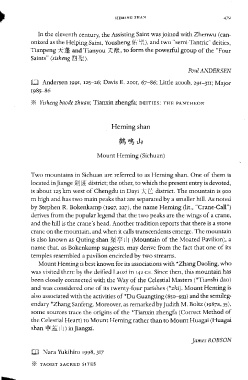Page 519 - The Encyclopedia of Taoism v1_A-L
P. 519
HEMING SHAN 479
In the eleventh century, the Assisting Saint was joined with Zhenwu (can-
onized as the Helping Saint, Yousheng 11'i 11/.!), and two "semi-Tantric" deities,
Tianpeng 7( JI and Tianyou X:. Wt, to form the powerful group of the "Four
Saints" (sisheng IZIl ~).
Poul ANDERSEN
[Dj Andersen 1991, 125-26; Davis E. 2001, 67-86; Little 2000b, 291-3II; Major
1985-86
* Yisheng baode zhuan; Tianxin zhengfa; DEITIES: THE PANTHEON
Heming shan
Mount Heming (Sichuan)
Two mountains in Sichuan are referred to as Heming shan. One of them is
located inJiange ~IJ M district; the other, to which the present entry is devoted,
is about 125 km west of Chengdu in Oayik r3 district. The mountain is 900
m high and has two main peaks that are separated by a smaller hill. As noted
by Stephen R. Bokenkamp (1997, 227), the name Heming (lit., "Crane-Call")
derives from the popular legend that the two peaks are the wings of a crane,
and the hill is the crane's head. Another tradition reports that there is a stone
crane on the mountain, and when it calls transcendents emerge. The mountain
is also known as Quting shan ~ 'T ill (Mountain of the Moated Pavilion), a
name that, as Bokenkamp suggests, may derive from the fact that one of its
temples resembled a pavilion encircled by two streams.
Mount Heming is best known for its associations with *Zhang Daoling, who
was visited there by the deified Laozi in 142 CE. Since then, this mountain has
been closely connected with the Way of the Celestial Masters (*Tianshi dao)
and was considered one of its twenty-four parishes (*zhi). Mount Heming is
also associated with the activities of *Ou Guangting (850-933) and the semileg-
endary *Zhang Sanfeng. Moreover, as remarked by Judith M. Boltz (1987a, 35),
some sources trace the origins of the *Tianxin zhengfa (Correct Method of
the Celestial Heart) to Mount Heming rather than to Mount Huagai (Huagai
shan ¥1i ill) in Jiangxi.
James ROBSON
m Nara Yukihiro 1998,31 7
* TAOIST SACRED SITES

